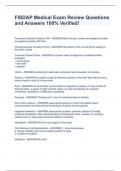FISDAP Medical Exam Review Questions
and Answers 100% Verified!
Transcient Ischemic Attack (TIA) - ANSWER-Minor stroke, where neurological function os regained quickly with time
Cerebrovascular accident (CVA) - ANSWER-disruption in the normal blood supply to the brain; stroke
Cincinnati Stroke Scale - ANSWER-a system used to diagnose a potential stroke ; assesses:
---facial droop
---arm drift
---speech
Clonic - ANSWER-pertaining to alternate contraction and relaxation of muscles
Seizure - ANSWER-a sudden surge of electrical activity in the brain that affects how a person feels or acts for a short time
Aura - ANSWER-An aura often occurs before a migraine or seizure. It may consist of flashing lights, a gleam of light, blurred vision, an odor, the feeling of a breeze, numbness, weakness, or difficulty in speaking.
Syncope - ANSWER-"Passing out", loss of consciousness or fainting
tonic-clonic seizure - ANSWER-generalized seizure in which the patient loses consciousness and has jerking movements of paired muscle groups
migraine headache - ANSWER-paroxysmal (sudden, periodic) attacks of mostly unilateral headache, often accompanied by disordered vision, nausea, or vomiting, lasting hours or days and caused by dilation of arteries
Headache - ANSWER-Pain in any region of the head
Oral Glucose Contraindications - ANSWER-1. Unconsciousness
2. Known diabetic who has not taken insulin for days
3. Unable to swallow
Influenza - ANSWER-flu virus Upper GI bleed - ANSWER-Bleeding in the upper gastric tract consisting of tarry stools and may be an indication for PUD or gastric cancers
Lower GI bleed - ANSWER-Bleeding in the lower gastric tract consisting or bright red or wine colored stool (hematachezia)
Medical Identification - ANSWER-Apparel such as tags, bracelets etc in order to identify
the patient or their medical history
heat stroke - ANSWER-a condition marked by fever and often by unconsciousness, caused by failure of the body's temperature-regulating mechanism when exposed to excessively high temperatures.
Organs of the Abdomen include: - ANSWER--Solid Organs: Spleen, Liver, Pancreas, Kidneys
-Hollow Organs: Stomach, Gallbladder, Duodenum, Large Intestine, Small Intestine, Bladder
Appendix
Regions of the abdomen - ANSWER-epigastric, umbilical, periumbilical, hypogastric, hypochondriac, lumbar, iliac/inguinal, RUQ, LUQ, RLQ, RUQ, suprapubic
Hypovolemic shock - ANSWER-Shock caused by fluid or blood loss.
Appendicitis - ANSWER-inflammation of the appendix
Anaphylaxis - ANSWER-a severe response to an allergen in which the symptoms develop quickly, and without help, the patient can die within a few minutes.
Epi-Pen Administration - ANSWER-Place the orange tip against the middle of the outer thigh (upper leg) at a right angle (perpendicular) to the thigh. Swing and push the auto-
injector firmly until it "clicks." The click signals that the injection has started. Hold firmly in place for 3 seconds (count slowly 1, 2, 3).
Epinephrine Cardiac system - ANSWER-Epinephrine causes constriction in many networks of minute blood vessels but dilates the blood vessels in the skeletal muscles and the liver. In the heart, it increases the rate and force of contraction, thus increasing the output of blood and raising blood pressure.
BSI/PPE - ANSWER-Body Substance Isolation and Personal Protective Equipment
Pathogens - ANSWER-disease causing agents
Salmonella - ANSWER-a bacterium that occurs mainly in the intestine, especially a serotype causing food poisoning.




